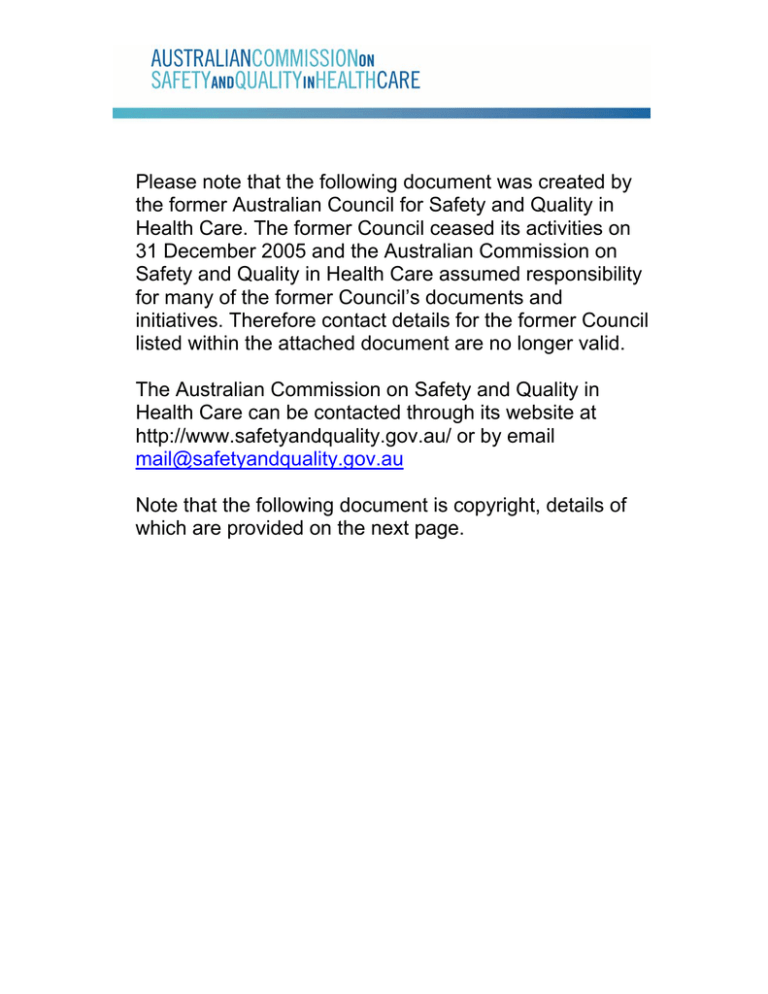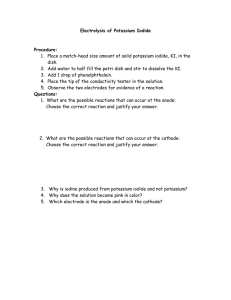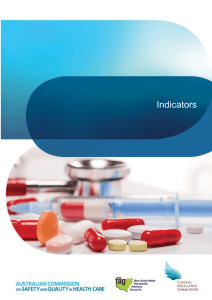High Risk Medication Alert Project
advertisement

Please note that the following document was created by the former Australian Council for Safety and Quality in Health Care. The former Council ceased its activities on 31 December 2005 and the Australian Commission on Safety and Quality in Health Care assumed responsibility for many of the former Council’s documents and initiatives. Therefore contact details for the former Council listed within the attached document are no longer valid. The Australian Commission on Safety and Quality in Health Care can be contacted through its website at http://www.safetyandquality.gov.au/ or by email mail@safetyandquality.gov.au Note that the following document is copyright, details of which are provided on the next page. The Australian Commission on Safety and Quality in Health Care was established in January 2006. It does not print, nor make available printed copies of, former Council publications. It does, however, encourage not for profit reproduction of former Council documents available on its website. Apart from not for profit reproduction, and any other use as permitted under the Copyright Act 1968, no part of former Council documents may be reproduced by any process without prior written permission from the Commonwealth available from the Attorney General's Department. Requests and inquiries concerning reproduction and rights should be addressed to Commonwealth Copyright Administration, Attorney General's Department, Robert Garran Offices, National Circuit, Barton ACT 2600 or posted at http://www.ag.gov.au/cca High Risk Medication Alert Project - Change Management Case Study Learning from the experience of others to assist your project……… From Austin Health, Victoria August 2003 QUESTIONS Why was potassium chloride (KCL) selected for the “change initiative”? Who “drove” the initiative and how were clinicians and managers involved? What data was used - overseas data, local data? One of the reported causes of fatal iatrogenic hyperkalaemia is inadvertent intravenous administration of concentrated potassium solutions. Following an investigation into a death caused by inadvertent rapid administration of intravenous potassium, the Victorian Coroner recommended drug protocols be unambiguous, and noted that using a pump to administer potassium chloride may have averted this event. Health authorities in US and UK have recommended removal of concentrated potassium chloride ampoules from wards. At Austin Health, local observations indicated contributing factors to inadvertent rapid administration included: • Similar packaging and labelling of commonly used ampoules e.g. KCl and saline ampoules are almost identical. • Inappropriate storage of ampoules of concentrated KCl solution near other ampoules. • Complacency about the potential hazards of potassium replacement therapies because of their routine use. • Inadequate use of guidelines for administration. • Lack of knowledge regarding potassium therapy e.g. mmol vs gram. The key root cause explaining most cases of fatal iatrogenic hyperkalaemia is storage of concentrated potassium chloride solutions on wards. This project was led by Dr Chris O’Callaghan, clinical pharmacologist and general physician and was supported by a grant from Department of Human Services (DHS), Victoria. Austin Health’s Medication Safety Sub-committee, reporting to the Drug and Therapeutics committee, was actively involved. QUESTIONS How was the team put together? Who was on the team? What was the importance of “driving the project” and giving it credibility? The existing Medication Safety Sub-committee comprises clinicians, pharmacists, nurses and clinical governance. A smaller team implementing the project was made up of a pharmacist (as the project officer), the Director of Pharmacy and a Senior Clinical Pharmacologist/Physician. This team had the expertise and enough power to lead the change and communicate the vision to others. Source: Austin Health, Victoria - August 2003 Page 1 High Risk Medication Alert Project - Change Management Case Study Learning from the experience of others to assist your project……… QUESTIONS What were the project aims and how were they communicated? What education strategies and tools were developed? The project aim was to improve the safety of potassium therapy at Austin Health. Prior to this project, ampoules containing 2 gram (26.8 mmol) potassium were stocked in wards together with commercially pre-mixed flasks containing 30 mmol potassium in 1000 mL of crystalloid. Measures were taken to reduce the likelihood of inadvertent bolus administration of KCl. The interventions were to: (i) remove concentrated ampoules from wards, (ii) standardise to the 10 mmol in 10 mL ampoule for areas where concentrated potassium cannot be removed, (iii) instruct prescribing to be in mmol, (iv) promote oral therapy where possible, (v) introduce a 100 mL infusion containing 10 mmol of potassium in a sodium chloride solution – this solution is isotonic. At Austin Health, a number of strategies were developed to communicate the change including: • Face to face communication: presentations at key meetings (Drug & Therapeutics Committee, Nursing (management, eductors, wards), Pharmacists, Doctors (senior, HMO and intern), pharmacy store staff. Presentations were delivered by different members of the project team. There was ‘lots of talking’ at any and every opportunity especially to nurses on wards - encouraging others to then communicate the message to colleagues. • Written information: posters and flyers on wards (including drug cupboards), pharmacy, and a notice in the drug safety bulletin. • Electronic information: Information on Intranet including answers to Frequently Asked Questions. QUESTIONS What barriers were encountered? There was “nothing suitable” to replace concentrated potassium with…. There were post implementation problems with….. • We identified the obstacles to the removal of concentrated ampoules by surveying prescribing and administration of potassium supplements to our inpatient population. This data could then be used to compare our post-intervention effectiveness. • We needed a clinically acceptable alternative to the ampoules to allow for the treatment of hypokalaemia. The appropriate concentration and method of administration was determined with input from the Medication Safety Sub-committee e.g. administration via a peripheral line, mandated use of pumps to control the rate, acceptable concentration, volume and fluid. • Stat orders for IV potassium chloride to maintain the serum potassium level within a certain range are common in ICU. However, there is a risk if these orders remain on drug charts when the patient is transferred to the ward. Source: Austin Health, Victoria - August 2003 Page 2 High Risk Medication Alert Project - Change Management Case Study Learning from the experience of others to assist your project……… QUESTIONS How were (or will) the barriers overcome? How was Baxter approached to make a 100 mL bag? How was the ICU problem fixed by changing the process? • Meetings were held with various specialist groups with particular work practices e.g. Haematology/Oncology, Paediatrics, Operating Theatre to determine if removal of ampoules was feasible. Overall, these groups were very supportive. • A small volume potassium minibag was manufactured (utilising money from the DHS grant) containing 10 mmol in 100 mL sodium chloride infusion solution. The formulation, labelling and features of the product were developed by the Medication Safety Subcommittee in consultation with The Alfred Hospital and Baxter Healthcare. • Specific unit protocols and patient care requirements have proven problematic e.g. 60 mmol flasks. This is not an uncommon request and can largely be overcome by using pre-mixes (6 x 10 mmol flasks run consecutively or made by our centralised IV Additive Service – although this is not a 24 hour/7 days per week service). Pharmacists have played a critical role in attempting to get orders changed to enable the use of pre-mixes. If this is not possible because of fluid restrictions or other specific patient requirements, then the ampoules are dispensed for the flask to be prepared on ward. QUESTIONS What were the short term wins? How did ICU change their processes as the project gathered momentum? • Prescribing in mmol was adopted. • ICU developed their protocol to prescribe in mmol and reduce their reliance on ‘prn’ orders for potassium maintenance. They ensured that these ‘prn’ orders were ceased prior to discharge to wards. ICU only keeps mmol ampoules. • The Anaesthetics service agreed to remove the ampoules from general stock, other than the theatres conducting cardiac surgery, and Recovery. QUESTIONS What next? What is still to be done, and what is the plan to do it?. (e.g. theatre, coronary care....) • Ensure sustainability (regularly review the stock issued, use of pre-mixes/ampoules, feedback from ward pharmacists on orders being changed to pre-mixed flasks. Determine viability of more concentrated, large volume supplement e.g. 60 mmol in 1000 mL. • Haematology/Oncology (specific but non-uniform requirements related to amphotericin therapy) and Paediatrics (protocols require 500 mL flasks to be used as maintenance). • Further protocol development is needed to address management of hypokalaemia more broadly. • Work with stakeholders to improve labelling of existing 30 mmol pre-mixed flasks. • Ensure the removal of ampoules has been completed (check stock holdings in other departments e.g. radiology, endoscopy suites etc.) • Post-implementation survey to assess effectiveness. Source: Austin Health, Victoria - August 2003 Page 3 High Risk Medication Alert Project - Change Management Case Study Learning from the experience of others to assist your project……… KEY HINTS Don’t stop too soon. Write protocols to match the premixes available. Theatre and Emergency Department – “flow on” from ICU so it was easier to implement change in these areas. You need high level support for the process then everything else will follow. Meet with Nurse unit managers to see how they can implement the recommendations on the ground. Keep in touch with ward pharmacists and other staff and elicit feedback. ACKNOWLEDGEMENTS Austin Health is kindly acknowledged for sharing their learning experiences via the notes provided in this Change Management Case Study. The notes were kindly prepared by: Anne McGrath, BPharm, GradDipHospPharm Project Officer, Medication Safety Sub-committee Austin Health, August 2003 Source: Austin Health, Victoria - August 2003 Page 4




